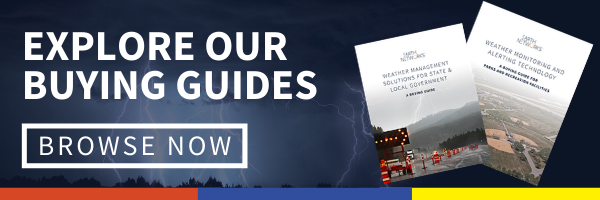Total Lightning Detection vs. Prediction
 Lightning detection vs. prediction: Which is better? This quick real case study will help you find out!
Lightning detection vs. prediction: Which is better? This quick real case study will help you find out!
Use the clickable table of contents below to jump to different areas of the piece. You can jump back up to the table at any time by clicking “Back to Top.”
TABLE OF CONTENTS
Want to Take a Copy with You?
Download a PDF version of the eBook you can reference later.
👇 Keep Scrolling to Start Reading!👇
Which System Better Safeguards Against Lightning?
The PGA Golf Professionals at a premier club on Hilton Head Island had a problem. While they invested and installed a new system that promised to predict lightning, it was not working and felt that the system had some deficiencies.
They researched alternatives and contacted Earth Networks to learn more about our total lightning detection solution. The club asked us how our solution would compare with the lightning system they had installed—and whether we could validate what they had experienced.
Case Study
Total Detection vs. Prediction 
We compared the data from our solution to data from their existing system from April – October 2013:
- The data analysis compared data from one system claiming to predict the probability of lightning to total lightning detection powering the Earth Networks offering.
- The system that claims to predict lightning senses the probability of lightning via a single sensor on a customer site – such as a golf course, a school, or a park.
- The Earth Networks solution detects actual real-time lightning strikes in the clouds and on the ground from the world’s largest lightning sensor network. Alerts are issued when lightning is detected within 10 miles or another customizable radius.
Comparative Analysis
- 49 total storms with lightning were tracked and examined.1
- Storms occurred between April–October 2013, the peak season for lightning danger.
- Storms were defined as an event with lightning within 10 miles—the distance recommended by the National Weather Service to help ensure safety.2
Summary
- The system that claims to predict lightning issued false alarms 16% of the time when there was no lightning within 10 miles of the course.
- The “prediction” system also performed poorly by issuing an early “all clear” 14% of the time; meaning there was still lightning present within 10 miles of the course.

On every metric, the Earth Networks Total Lightning Solution beat the system that claims to predict lightning.

The Earth Networks Total Lightning Advantage

Network Approach: Sensors are part of a network, and all detect and report lightning risk in unison – even if one sensor happens to go down. Deploying just one sensor means there is backup in place should the sensor go offline.
Detects Total Lightning: Detects in-cloud and cloud-to-ground lightning, a capability that is well beyond that of existing networks and single-node “prediction” systems.
Comprehensive Alerting: High rates of in-cloud lightning serve as precursory indicators of the potential for severe weather. Alerts for lightning and severe weather can be set for multiple locations and delivered via multiple methods – mobile devices, computers, and mass outdoor alerting systems
Know the Facts About Lightning “Prediction”
- Most lightning experts agree that it’s impossible to predict exactly when and where lightning will strike
- “Vendors who claim to ‘predict’ lightning in advance (which is impossible; it’s just guesswork) should be rejected.” – Source: The National Lightning Safety Institute
- Since in-cloud lightning often precedes cloud-to-ground strikes, relying only on cloud-to-ground strikes, let alone predicting them, does not provide the fastest warnings.
“Consider subscribing to a commercial, real-time lightning detection service that has been independently and objectively verified… Other commercial services claim to predict lightning
rather than detect and report on lightning that is already present. Unfortunately, all devices have certain shortfalls, and many have not been independently or objectively verified.”
– Source: National Athletic Trainer’s Association
Thanks for Reading!
Thank you for reading our eBook: “Total Lightning Detection vs. Lightning Prediction: Which System Better Safeguards Against Lightning.”
Don’t Forget Your Forever Copy!
Download a PDF version of the eBook you can reference later.
Now that you know total lightning detection is the best safeguard against lightning, it’s a good time to learn more about the life-saving tools it powers!
We designed our industry-specific buying guides to help you build a comprehensive weather safety solution rooted in the science of total lightning detection. Check them out and make sure your weather safety tools are as effective as possible.




